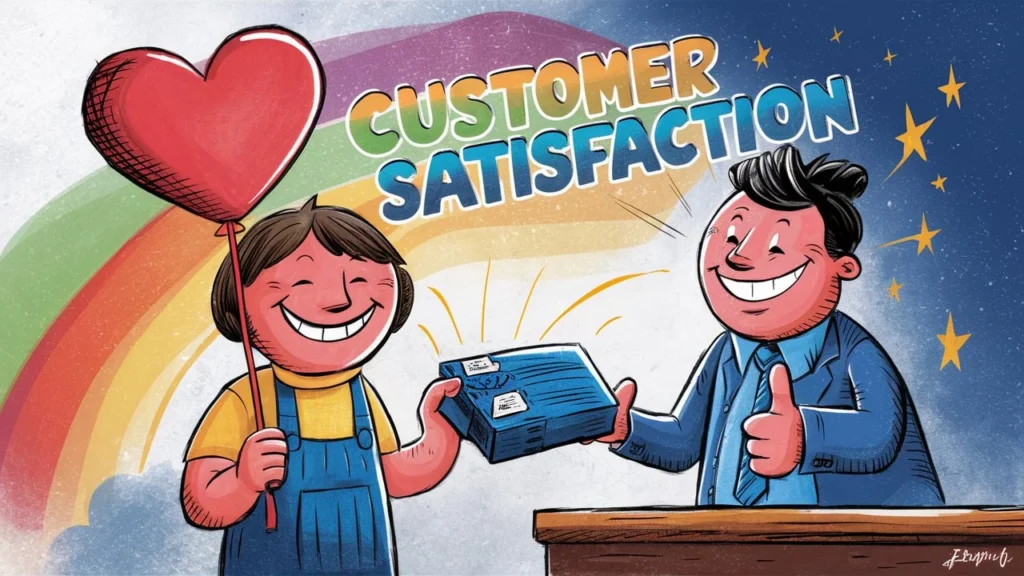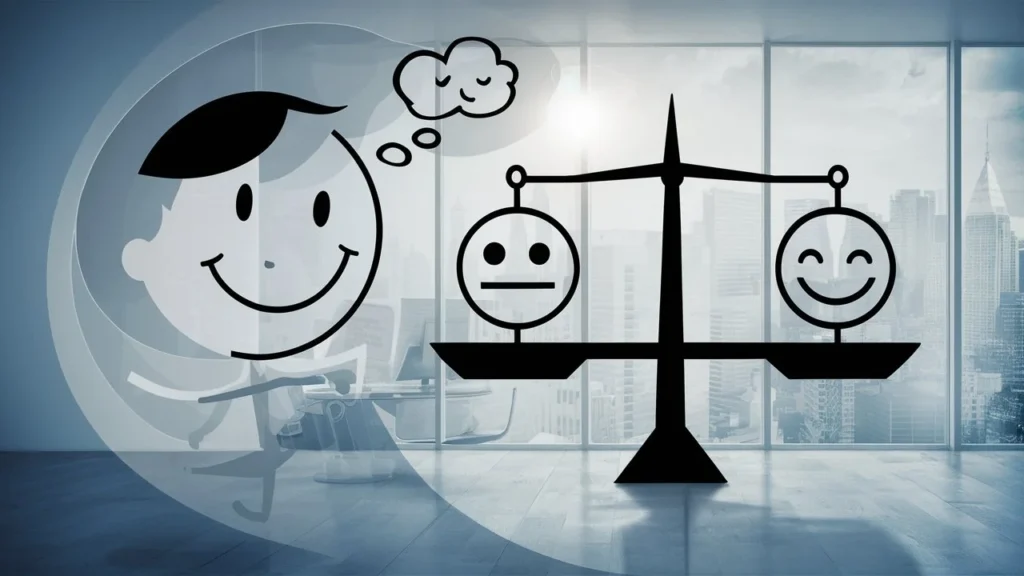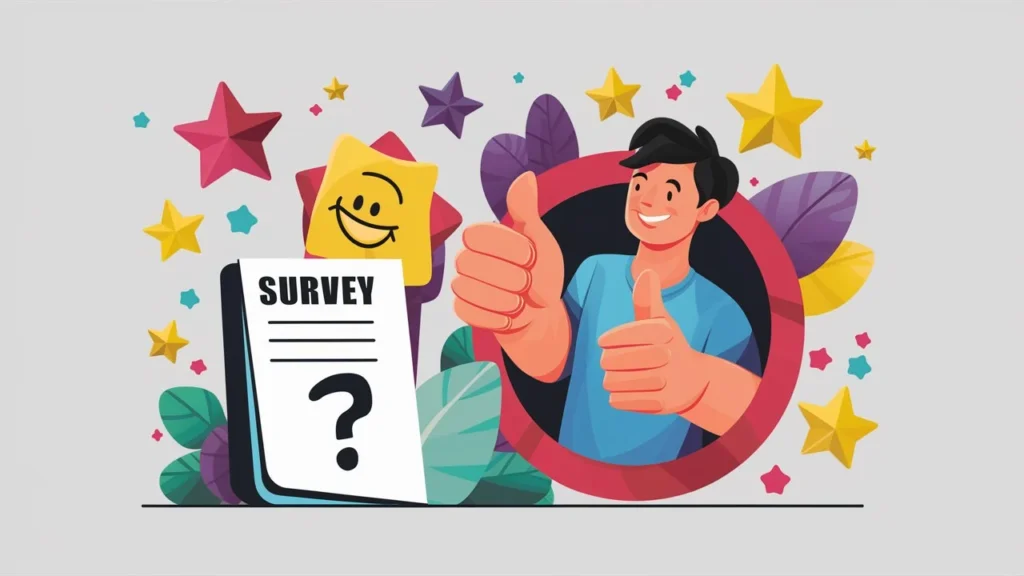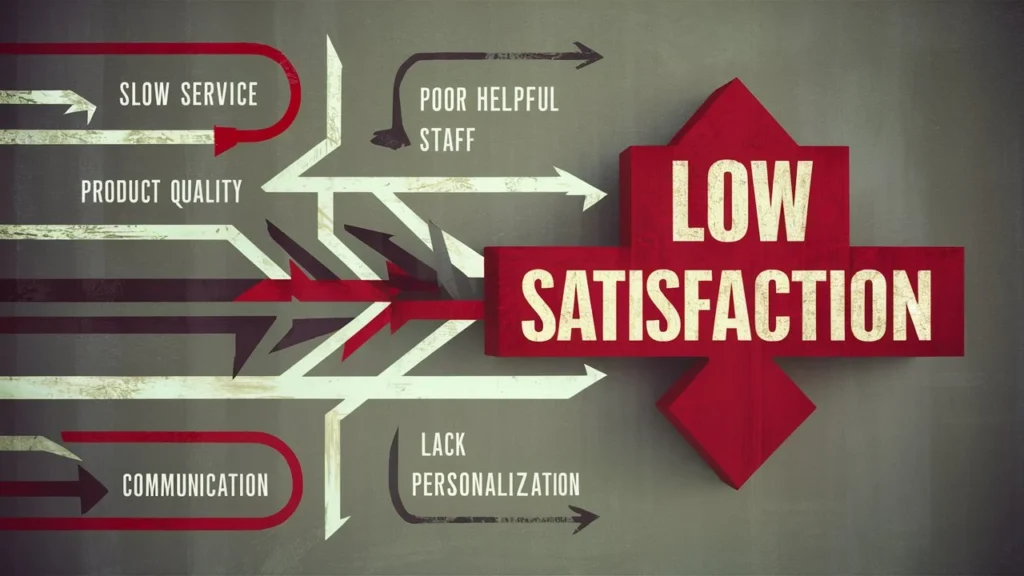How to Improve Customer Satisfaction

Customer satisfaction is the key to a thriving business. It’s all about how happy your customers are with your products, services, and interactions with your company. Building strong customer satisfaction and relationships goes beyond just CSAT scores. Learn how to “improve customer satisfaction” through a powerful strategy to connect with your customers and drive loyalty.
In this Post, We’ll Cover:
- What is customer satisfaction?
- Why is customer satisfaction important?
- How do you measure customer satisfaction?
- Boost customer satisfaction with surveys
- What causes low customer satisfaction?
What is customer satisfaction?

Customer satisfaction is a business metric. It reflects how happy customers are with a company’s products, services, and experience. It rates how well a company meets or exceeds customer expectations.
High customer satisfaction is important for businesses because it leads to:
- Increased customer loyalty and repeat business
- Positive word-of-mouth marketing and referrals
- Improved customer lifetime value
- A competitive advantage
Companies can measure and improve customer satisfaction. They can use surveys, feedback forms, and social media sentiment analysis. They can also use customer reviews.
Businesses can improve their products and services by understanding their customers’ thoughts and feelings. They can also improve how they serve customers. This creates a positive cycle. Better satisfaction leads to more satisfied customers.
Identifying and closing the holes in their experience. While some uncovering might be on your own, often the best insights come straight from them. After all, feeling heard and valued is what truly makes a customer satisfied.
So, when we discuss customer satisfaction. It’s all about active listening and taking action. We want every touchpoint to be positive. They should be positive across every channel and throughout their journey.
If we achieve that the customers are more likely to return. They’ll become loyal to our brand. And, they will reward us with high CSAT scores.
Also, Read:
Why is customer satisfaction important?

Customer satisfaction is critical for business success as it directly affects profits and long-term growth. A McKinsey & Company, study suggests that measuring satisfaction at every step of the customer journey is 30% more effective. It is better at predicting overall satisfaction than just gauging happiness at each touchpoint.
Also, focusing on customer journey satisfaction can bring a triple win. It can raise customer satisfaction by 20%, increase revenue by 15%, and cut service costs by 20%.
Here’s a breakdown of why it’s so important:
Boosts Loyalty and Repeat Business:
- Happy customers are more likely to come back for future purchases. Studies show that “totally satisfied” customers. They have repeat purchase rates 3-10 times higher than “somewhat satisfied” ones. Loyal customers bring a steady income. They also help businesses predict future revenue.
Free Marketing Through Word-of-Mouth:
- Satisfied customers spread the word! They recommend products or services to friends and family. They also recommend them online, generating free positive publicity. Today, in the digital age, online reviews and social media posts can make or break a business.
Increases Customer Lifetime Value:
- Keeping existing customers happy is more cost-effective than acquiring new ones. Focusing on satisfaction helps businesses. It can increase the total amount spent by a customer over their lifetime.
Improves Competitive Advantage:
- In a crowded marketplace, happy customers can give a business a leg up on the competition. When customers have positive experiences, they’re less likely to switch to another brand.
Provides Valuable Feedback:
- To Improve Customer satisfaction surveys and reviews give businesses valuable insights into how they’re performing. This feedback helps find areas for improvement in products, services, and customer service. It lets businesses constantly adapt and meet changing customer needs.
Overall, customer satisfaction is a key driver of business growth and profitability. By making customer happiness a priority, businesses can build strong relationships with customers. This will foster loyalty and bring sustainable success.
Also, Read:
How do you measure customer satisfaction?

There are several methods to measure customer satisfaction, each offering a unique perspective. Here are some common approaches:
Direct Feedback Methods:
- Customer Satisfaction Surveys (CSAT): The surveys ask customers to rate their satisfaction level. They rate the level for a specific interaction, product, or service. They often use a scale of 1 to 5 (or similar) with questions like “How satisfied are you with…?” CSAT scores provide a quick snapshot of customer sentiment at a particular touchpoint.
- Net Promoter Score (NPS): This single-question customer satisfaction survey asks how likely a customer is to recommend your business to others. They rate this on a 0-10 scale. NPS scores categorize customers. Promoters are highly likely to recommend it. Passives are neutral. Detractors are unlikely to recommend it. This helps assess customer loyalty and potential for word-of-mouth marketing.
Customer Behavior Metrics:
- Customer Effort Score (CES): This metric gauges how easy it is for customers to complete tasks or resolve issues. Businesses may ask about their recent experience. They can ask how much effort it took. A low CES score means a smooth experience. A high score suggests areas to improve.
- Customer Retention Rate: It is the percentage of customers who keep using a business’s products or services. It is over a specific period. Customer satisfaction and loyalty are indicated by high retention rates.
- Customer Lifetime Value (CLV): The total revenue a customer is expected to generate. It’s throughout their relationship with the business. Focusing on increasing CLV emphasizes keeping existing customers happy.
Social Listening and Reviews:
- Online Review Analysis: Monitoring customer reviews is done on platforms like Google My Business, Yelp, or social media. It can reveal valuable insights into customer sentiment. Analyzing trends and addressing negative feedback proactively demonstrates responsiveness to customer concerns.
- Social Media Listening: Tracking brand mentions and analyzing social media sentiment can paint a broader picture. They show customer satisfaction. This lets businesses find areas where customers have good or bad experiences.
Businesses can use these methods together. They can gain a full understanding of customer satisfaction across different touchpoints. This data can then be used to find areas to improve. It can also personalize the customer experience. It improves customer relationships.
Also, Read:
Boost customer satisfaction with surveys

Surveys are a powerful tool and free survey maker are cheery on the top to boost and improve customer satisfaction. They give you a direct line to what your customers think and feel. Here’s how to leverage surveys effectively:
Crafting Effective Surveys:
- Ask the Right Questions: Don’t just ask general questions. Tailor your customer satisfaction survey to specific touchpoints in the customer journey. For example, after a purchase or after a service interaction. Focus on the feedback you can act on. It helps you see what’s working and where you can improve.
- Keep it Short and Sweet: People are busy. Short surveys have clear, brief questions. People are more likely to finish them.
- Offer Multiple Choice and Likert Scales: These formats make it easy for customers to respond and provide you with data that’s easy to analyze. Open-ended questions can be valuable for deeper insights but use them sparingly.
Optimizing Survey Distribution:
- Target the Right Audience: Don’t blast surveys to everyone. Send them to customers who have just interacted with your brand at a specific touchpoint.
- Choose the Right Channel: Send surveys by email, embed them on your website or app, or send them by SMS. Choose based on the situation.
- Timing is Key: Send surveys soon after a customer interaction. Do this while the experience is fresh in their mind.
Taking Action on Feedback:
- Analyze the Results: Don’t just collect data, identify trends and areas where customer satisfaction is lagging.
- Respond to Feedback: Acknowledge both positive and negative feedback. Thank customers for their input and address any concerns promptly.
- Implement Changes: Take action based on the feedback. Use what you learn to improve your products, services, or customer service.
Following the given tips will help you gather customer satisfaction data effectively. Then, use it to get insights. The insights will improve your customer experience and boost satisfaction.
Remember, the key is to close the loop. Listen to your customers, act, and show them their feedback matters.
Also, Read:
What causes low customer satisfaction?

Satisfaction can dip for many reasons. It’s often due to a gap between what customers expect and what they experience.
Here are some common culprits:
Product or Service Issues:
- Poor Quality: Defective products break easily. They also don’t perform as advertised. They will disappoint customers.
- Doesn’t Meet Needs: If a product or service fails to meet a customer’s needs or solve their problem, it frustrates them.
Customer Service Shortcomings:
- Long Wait Times: Being kept on hold or waiting for a long time for assistance is a major pain for customers.
- Unhelpful or Unknowledgeable Staff: Customer service representatives are rude or dismissive. They also lack the knowledge to solve problems well. This creates a bad experience.
- Inefficient Processes: Complex or cumbersome procedures for returns, exchanges, or troubleshooting can cause frustration.
Communication Breakdowns:
- Mixed Messages: Different messages in marketing, sales, and customer service confuse customers. They create false expectations.
- Lack of Transparency: If customers are left in the dark about issues or delays, it can erode trust and satisfaction.
- Unresponsive to Feedback: Ignoring customer complaints or failing to acknowledge feedback shows a lack of concern. It can damage relationships.
Other Factors:
- Pricing Concerns: Customers feel they’re overcharged. It can lead to dissatisfaction.
- Unexpected Changes: Sudden price hikes, policy changes, or feature removals can upset customers. This is especially true if they are introduced without proper communication.
- Competitor Advantage: Better products, services, or experiences from competitors can steal customer satisfaction and loyalty.
By pinpointing the root causes of dissatisfaction, businesses can address them strategically. This might mean improving product quality. It could involve better customer service training, simpler processes, or clearer communication.
The goal is to match customer expectations with their experience. This ensures customers feel valued throughout their journey.
Level Up Your Research
Dive deeper than ever before and find the information you need to succeed
Frequently Asked Questions (FAQs):
What is customer satisfaction and why is it important?
Customer satisfaction measures how happy customers are with a company’s products, services, and interactions. It’s a crucial part. It affects a business’s bottom line. It does this by boosting customer loyalty repeat business, positive word-of-mouth, and competitive advantage.
How can a business measure customer satisfaction?
There are several methods to measure customer satisfaction. It includes customer satisfaction surveys (CSAT) and Net Promoter Score (NPS). Also, customer effort score (CES), customer retention rate, and customer lifetime value (CLV). Plus, social media listening and online review analysis.
What are some of the benefits of high customer satisfaction?
High customer satisfaction leads to more customer loyalty and, also leads to repeat business. It includes free marketing through positive word-of-mouth and better customer lifetime value. It gives a competitive edge in the marketplace.
What are some tips for crafting effective customer satisfaction surveys?
- Ask specific questions tailored to the customer journey touchpoint.
- Keep it short and sweet with clear, concise questions.
- Use multiple-choice and Likert scales for easy response and analysis.
- Consider offering incentives for participation, especially for longer surveys.
How can businesses target the right audience for their surveys?
Surveys should target customers. They should have recently interacted with the brand at a specific touchpoint.
What are some best practices for distributing customer satisfaction surveys?
- Choose the right channel (email, website, SMS) based on the situation.
- Distribute surveys soon after a customer interaction for a fresh memory.
How should businesses analyze and respond to customer survey feedback?
- Identify trends and areas for improvement.
- Acknowledge both positive and negative feedback.
- Take action based on the feedback to improve products, services, or customer service.
What are some common causes of low customer satisfaction with products or services?
- Poor product quality or products not meeting customer needs.
- Long wait times, unhelpful customer service representatives, or inefficient customer service processes.
- Mixed messages, lack of transparency, or being unresponsive to customer feedback.
How can businesses improve customer satisfaction through better customer service?
- Enhance customer service training to improve response time, knowledge, and helpfulness.
- Streamline processes for returns, exchanges, or troubleshooting to reduce customer frustration.
What are some ways to avoid communication breakdowns that can lead to customer dissatisfaction?
- Ensure consistent messaging across marketing, sales, and customer service.
- Maintain transparency with customers about issues or delays.
- Be responsive to customer inquiries and feedback.
How can businesses address pricing concerns and keep customers satisfied?
- Communicate the value proposition behind product or service pricing.
- Offer fair pricing that reflects the quality and benefits provided.
- Consider flexible pricing options or loyalty programs to enhance value for customers.
How does customer satisfaction relate to customer loyalty and repeat business?
Satisfied customers are more inclined to come back for more purchases, resulting in greater customer loyalty and recurrent business.
What is the role of word-of-mouth marketing in customer satisfaction and loyalty?
Happy customers spread the word. They give positive recommendations to friends, family, and online. This creates free marketing and boosts customer loyalty.
How can businesses leverage customer satisfaction to gain a competitive advantage?
By making customer satisfaction a priority, businesses can build stronger customer relationships. They can also build loyalty. They can stand out from competitors with less satisfied customers.
How can businesses leverage customer satisfaction to gain a competitive advantage?
By making customer satisfaction a priority, businesses can build stronger customer relationships. They can also build loyalty. They can stand out from competitors with less satisfied customers.
What are some strategies for building strong customer relationships and fostering loyalty?
- Listen to customers and act on their feedback to solve any issues.
- Personalize the customer experience whenever possible.
- Use loyalty programs or reward systems to encourage customers to come back.
- Proactively engage with customers and provide excellent service throughout their journey.
Conclusion
Customer satisfaction is a key metric for businesses. It shows how well they meet customer expectations. Businesses can measure satisfaction. They can find ways to improve. Doing this helps them build better customer relationships. They do this by addressing concerns. This also fosters loyalty and leads to long-term success. Remember, happy customers are the foundation of a thriving business.



